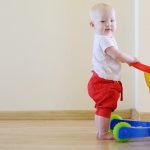 When it comes to toddler communication milestones, we often focus on skills like expressive language, vocabulary, or articulation. We sometimes forget that being a good listener is also an essential part of being a good communicator! But being a good listener isn’t just about being polite. (Although we love manners! Here’s how to start teaching manners, even in toddlerhood.)
When it comes to toddler communication milestones, we often focus on skills like expressive language, vocabulary, or articulation. We sometimes forget that being a good listener is also an essential part of being a good communicator! But being a good listener isn’t just about being polite. (Although we love manners! Here’s how to start teaching manners, even in toddlerhood.)
Highlights:
|
What is Active Listening?
When we’re actively listening, we don’t simply hear a message. We make a conscious effort to pay attention to, understand, and respond to what someone is saying. It is a very complex skill that will take many years for your toddler to master, but eventually it will help them:
- Focus on the message, emotions, and perspective of the speaker.
- Demonstrate attention through non-verbal communication, such as maintaining eye contact and using appropriate gestures and facial expressions.
- Remain aware of how their experiences, assumptions, or opinions affect how they receive the speaker’s message.
- Refrain from interrupting.
It takes time and effort to master active listening skills. That’s why it’s so important to start early! In fact, many adults lack effective active listening skills. Research suggests that we only remember about 25-50% of what a speaker is saying. Taking the time to lay the foundation for your toddler’s active listening skills now can provide a lot of benefits for them in the future.
Why is Active Listening Important?
On a fundamental level, active listening is central to learning. By practicing active listening with your child now, you are preparing them to be effective listeners in school. Active listening skills are also closely tied to following directions, effective communication, better relationships, critical thinking, leadership, empathy, and emotional intelligence.
How Does Active Listening Develop?
Generally, active listening skills develop as follows, although all children may not fit perfectly into this timeline!
Months 25-27 – Can actively listen for about 3-6 minutes.
Months 28-30 – Improved active listening skills lead to asking questions during conversations.
Months 31-33 – Can actively listen for about 6-10 minutes.
How Can You Support Your Child’s Active Listening Skills?
Here are some key ways to build your little one’s active listening abilities:
Support receptive language skills. Receptive language allow us to make sense of and respond to the information we hear and see. It’s a central part of active listening. In this article you can learn how to nurture your little one’s receptive language.
Read! When you read to your child they are taking in information auditorily and visually, and analyzing it in order to understand. When you engage in interactive reading, you give their listening skills an extra boost.
Focus on attention skills. Strong attention skills are necessary for active listening. In this article you can learn ways to support your child’s developing attention skills.
Model listening skills. Even when your child is very young, consistently dedicating time (even a few minutes a day!) to actively listen to them is a powerful way to help them become active listeners themselves. Fully focus on what they say, and paraphrase or ask questions to show that you are engaged.
Try our BabySparks active listening activities. You can find fun ways to practice this skill with your toddler in the speech area of our development program.
It will take many moons for your child to master active listening, but there’s no better time than now to introduce this significant communication skill.








